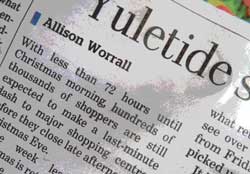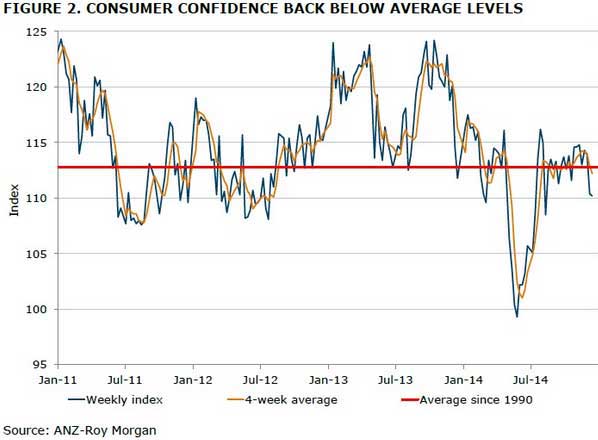Reviewing the various reports on Christmas spending at retail, it seems pretty clear that, while by late November/early December Australians were preparing to indulge in a spending orgy the likes of which Australia had seldom experienced, they have since that time undergone a crisis of confidence so severe that many must be having difficulty getting out of their beds, let alone finding their way into retail outlets.

First came confident predictions in late November of a couple of billion dollars in increased Christmas sales, which was rapidly followed by news in early December that the country has totally lost its mojo, spending-wise. So what’s it to be, a nation of shoppers shadowed by a black dog of existential ennui? Or spending like drunken sailors? Someone must be wrong.
As a keen follower of the retail prediction business, I can tell you that this year’s crop is no less bountiful, but if anything more contradictory that previous years.
It needs to be understood that the one role such predictions might usefully play – assisting retailers in planning stock and staffing levels for the critical Christmas selling season – has nothing whatsoever to do with why they are issued with such regularity.
Some are there to gain publicity and branding exposure for their sponsors, generally banks (and grim ones are the best as ‘bad news sells’) and the more chipper ones might just encourage Australians to do what the sponsor or research organisation says they are going to do – the power of positive suggestion in action.
The Conbank-Serapax Matrix of Consumer Bliss is all about putting the bank brand about and rolling out their ‘Chief Economist’ for some beard-stroking and fortune-telling. And one would imagine that any one of the umpteen associations claiming to represent Australian retailers wants to see a buying frenzy right across this wide brown land. And sure enough, that’s what they are predicting!
The National Retail Association (NRA) predicted in late November that consumers will spend more than $43 billion across all retail categories in the lead up to Christmas Day – 5 per cent higher than the $40.7 billion in sales recorded in 2013.
And according to data by the ARA (as opposed to the NRA) and Roy Morgan, Australian shoppers were tipped to spend $45 billion from November 15 until December 24, representing a 4.3 per cent gain on sales during the same period in 2013 ($43 billion). The best Christmas in five years, according to the ARA, ‘without a doubt’.
– You see, on November 24 it was announced that the ANZ/Roy Morgan consumer confidence index (a separate gig to the ARA one) rose 1.2 per cent the week before, partly reversing a 1.6 per cent fall the previous week. ANZ chief economist, Warren Hogan, said the improvement was driven by more positive expectations about household finances.
‘Alongside low interest rates and rising house prices, this should support consumer confidence and retail spending as we head into the Christmas season,’ he tipped.
No argument there from rival market researcher IbisWorld – it was going to be a wonderful Christmas, it announced on the same day. Consumer confidence was slowly improving, which should result in a pick up in spending. Sales up 5.5 percent on the same period last year with $30 billion to be spent. A 35 percent increase in sales on November. (Well, yes, that’s because Christmas falls in December!)
But it’s not all upside, according to IbisWorld retail analyst Lauren Magner. She had some great tips for retailers: ‘Retailers need to hire sufficient staff to cover the spike in demand but also be able to cut back once demand drops off after Christmas’, she advised. Managing inventory is also important, apparently. You need to meet demand but not overstock. So no only encouraging market research but insightful retail management tips.
Confidence tricked
Then something really bad happened – must have been the first week in December. Australians’ confidence went pair-shaped all of a sudden. (Was that perhaps when the latest unemployment figures were announced?)
First cab off the rank with the bad news was the Westpac-Melbourne Institute Index. The bloody thing fell 5.7 per cent in December to a level of 91.1! Westpac chief economist Bill Evans said the index now at its lowest level since August 2011. He actually described it as ‘disturbing’.
Disturbing for chief economists, maybe, but confounding for retailers who the week before had been led to believe they were in for a bumper year. The detumescing confidence index was putting bad thoughts in consumers’ heads. They were planning to cut back on spending. The index tracking whether people think it is a good time to buy a major household item down 11.8 percent.
Then Andrew McLennan, a retail analyst at Commonwealth Bank, piped up and said the bank’s credit card data showed momentum in the retail sector was starting to slow at ‘discretionary retailers and staples stores’! (But then again, you would have to have a lot of stapling to do to justify paying with a credit card.)
Westpac’s St George Bank pluckily defied its parent’s predictions by polishing up a lacklustre set of figures to accentuate the positive. For one thing, less people than last year intend to spend less than they did last year, if you get the drift: ‘Eighteen percent of respondents said they would reduce spending this year, down from 28 per cent last year.’ Now that can’t be a bad thing. And this was married to a certain devil-may-care, tomorrow-may-never-come attitude: ‘An increasing portion of Australians – 23 per cent, up 5 per cent year on year – say they are not worried about costs this Christmas.’
But unfortunately, that 77 percent who were worried about Christmas were getting the heeby-geebies. In the first week of December, the ANZ-Roy Morgan Weekly Consumer Confidence Index fell 3.1 percent to 110.4. Come on people, cheer up – Christmas is coming!

The ANZ said that the key driver ‘was a sharp decline in confidence in the economic outlook, likely reflecting the weak GDP data and media focus on the government’s economic management last week’.
And it was going from bad to worse: ANZ-Roy Morgan Consumer Confidence declined another 0.2 percent to 110.2 in the week ending December 14. Not only that, but the all-important sub-index was down a cumulative 13.7 percent. Not disturbing, according to Mr Hogan, but nonetheless ‘disappointing’.
The Westpac-Melbourne Institute Index of consumer sentiment concurred, slumping to a three-year low in December. (And how’s this for most insensitive introductory par of the year from The Australian: ‘Yesterday’s hostage crisis in Sydney could not have come at a worse time for Australian consumer sentiment...’)
But just as it seemed all was lost – hope again! Maybe not for Christmas – but the Boxing Day sales are going to be un-beleevable.
Shoppers are expected to spend $16.1 billion during post Christmas sales from Boxing Day through to January 15, 2015 according to ‘new research released by the Australian Retailers Association and Roy Morgan.’
The $16.1 billion represents an estimated year on year growth of 3.6 per cent.
All states and territories are predicted to experience positive growth post-Christmas, ranging from 1.2 per cent in the ACT to 4.2 per cent in NSW.
So according to the ARA that’s $45 million pre-Christmas and another $16 million from Boxing Day to January 1. Sixty-one million bucks in total. .
‘Previous ARA/Roy Morgan Christmas research has been almost spot on every time, meaning retailers can be quite confident that this Christmas will be a merry one,’ Mr Zimmerman said. (Although this week he was quoted by Fairfax Media as saying, ‘It’s been a little softer than what retailers would have liked to see…’)
Meanwhile, in the real world…
In researching this article I came across two quotes from actual retailers, rather than bank economists or retail association spinmeisters. One was from the lovable and cuddly Gerry Harvey, who observed that: ‘I think there’s been a bit of alarmist news out there. If you look at what’s happening in our stores, our sales and the people coming in, it’s all very good.
‘Going back for as long as I can remember, if Harvey Norman is going well, everyone is going well. If Harvey Norman is going bad, then everyone is going bad.’
Another retailer made the following observation in response to one (I’ve lost track of which) of the more sunnier sets of predictions:
Are we living in parallel universes? I seriously question if any sector is experiencing growth based on this week vs this week last year. When I question my customers they all state they are cutting back on discretional spending – ie, only buying food, petrol, kids clothing, etc. This is in wealthy Sydney city centre so I can only guess how it might be regionally. I agree let’s not talk ourselves into a recession but let’s also be realistic.
For the record, photo retailers we’ve spoken to over the past couple of weeks are saying that December has picked up after a pretty grim couple of months. Sales are ‘on target’ or ‘around the same as last year’.





Be First to Comment